
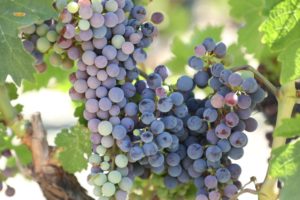
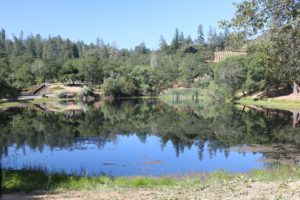 Heritage School Vineyards. The roots of Heritage School Vineyards date back to the previous ownership when the property and wine brand was called Harris Estate Vineyards, founded by the husband wife team of Mike & Treva Harris. We first met with Mike at the estate and then later followed up by tasting at their appointment only outlet, Salon St. Helena in downtown St. Helena which was only open for a short while (permanently closed).
Heritage School Vineyards. The roots of Heritage School Vineyards date back to the previous ownership when the property and wine brand was called Harris Estate Vineyards, founded by the husband wife team of Mike & Treva Harris. We first met with Mike at the estate and then later followed up by tasting at their appointment only outlet, Salon St. Helena in downtown St. Helena which was only open for a short while (permanently closed).
Mike & Treva purchased 48.6 wooded acres here in 1997 and then cleared 7 acres for planting vines; the property features an elevation change of approximately 450 feet. The vineyards are located in a unique part of Napa Valley among hills in the Mayacamas mountains within a short drive of Calistoga. Nearby vineyard neighbor, Mike Grgich of Grgich Hills Winery has farmed this area for many years and some of the grapes from Mike Grgich’s vineyard were used in the 1973 Chateau Montelena Zinfandel, the same vintage but a different variety than the winning entry at the Paris Tasting of 1976. Also, a nearby estate vineyard provides grapes for the premium brand, LEVY & MCCLELLAND. This is a fine vineyard neighborhood, albeit well off the radar of most visitors to Napa Valley.
Franz Valley School Road, Franz Valley Road and Franz Valley are named in honor of Captain Frederick Franz who settled in nearby Franz Valley, Sonoma County in 1857 with his wife Sarah. The deed to his property was dated January 31, 1857. He built a basic road into Knights Valley which was eventually known as the Captain’s Road and constructed a home. Their daughter Minnie was born in the home and lived here almost all of her life until passing in 1931. The home survived until 1964 when it was completely burned in the Hanley Fire. Frederick and Sarah are buried in the St. Helena Cemetery.
Serious wine enthusiasts David and Linda Jenkins first visited the property in 2007. Their daughters Missiaen, Casey, Hannah, and Julie also assist as needed. In 2014 the Jenkins acquired Harris Estate Vineyards from the Harris’s and then renamed the property and wine brand to Heritage School Vineyards. The last we heard, Mike and Treva moved to Park City, Utah.
Four uniquely different vineyards are located on the property, each of which is approximately 4 acres. Three existing vineyards at the time of their purchase included Hillside Vineyard (arguably the best views from the property), Lakeview Vineyard and Creekside Vineyard, planted on site of the former school ball field. Each vineyard features unique soils and microclimates translating to distinctive wines, each representative of the site. The total vineyard encompasses 8.3 acres and each of the distinctive vineyards are planted entirely to Cabernet Sauvignon (primarily to clone 337).
Hillside Vineyard is the highest vineyard on the property and features slopes up to 25 degrees and red very rocky soils reminiscent of the soil types found across the valley on Howell Mountain or in parts of Oakville. The wines produced from this vineyard are often high in fruit flavors with higher alcohol levels. The grapes are small with a high skin to juice ratio. During the growing season, this vineyard receives the most sunshine hours.
Lakeview Vineyard is planted in very chalky/volcanic soils and produces wines that often display inherent spices on the palate, regardless of vintage. This vineyard is planted to clones 6 and 685; this latter clone was previously Petit Verdot and was budded over to Cabernet Sauvignon in 2002. A natural spring fed creek flows on the property all year long. The name of this vineyard is in reference to a small lake created by a dam built here in the 1950s. A nearby ridge helps trap cooler air on Lakeside Vineyard along with the nearby Chalk Hill Gap funneling in cooler air from Sonoma County to the west.
Creekside Vineyard is the lowest vineyard on the property and produces a Bordeaux style wine with bright acidity; it is this wine of their three vineyards that perhaps has the longest aging potential. This vineyard can be up to 10 degrees cooler than the higher blocks at the same time on the same day. And it tends to be up to two weeks behind the other vineyards in terms of both budbreak and harvest. The soils here are primarily clay-like. And it is the only block on the property that is dry farmed.
And their most recent vineyard is Indulgence, planted in 2017 to the Jenkins clone of Cabernet Sauvignon. Remarkably this vineyard produced enough grapes to harvest a year later in 2018. All four vineyards are not harvested at the same time – with time between the first and last harvest often lasting up to a month.
For small production and small acreage the dramatic differences in their vineyards certainly make this property unique. Because of the soil types, these vineyards are a classic example of how different terroir influences the wine flavors and structure. After walking the vineyards for the first time their founding winemaker Mark Herold said, “If I can’t make great wine from this fruit, you should fire me!”
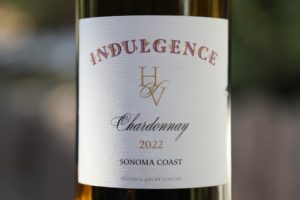
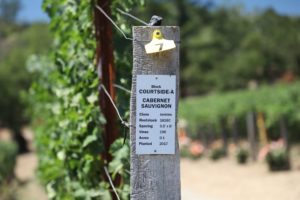
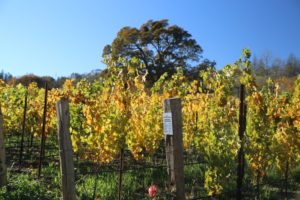 Thomas Brown has been the winemaker here since 2006; Thomas is one of the busiest wine makers in Napa Valley. Several producers have showed us lists of all the Napa brands that he consults for and or provides direct winemaking services; this is an extensive list. He is from South Carolina and developed an interest in wine while attending the University of Virginia where his major was not wine related; he studied English and Economics.
Thomas Brown has been the winemaker here since 2006; Thomas is one of the busiest wine makers in Napa Valley. Several producers have showed us lists of all the Napa brands that he consults for and or provides direct winemaking services; this is an extensive list. He is from South Carolina and developed an interest in wine while attending the University of Virginia where his major was not wine related; he studied English and Economics.
He moved to Napa Valley in 1996 and took a job at All Seasons Bistro in Calistoga, known for their California cuisine, wine selection and two decades in business – but unfortunately permanently closed in 2020. While there, Thomas met winemaker Ehren Jordan who was working for Larry Turley at the time of Turley Wine Cellars. Thomas took a job with Ehren in the cellar at Turley in 1997 – spent several years there before beginning his own career and starting to consult for various clients, some of which were clients that Ehren was already working with.
And within only 10 years of making wine in Napa Valley Thomas received two 100-point scores from Robert Parker; regardless of what your perception is of scores, creating several wines within a short period of time that receive 100 points from Parker was a watershed moment in Thomas’s consulting career.
Today Thomas is highly sought after for his winemaking services, experience and access to premium area vineyards. And while he was once the student, over the years he has become the teacher. We have met with a number of winemakers who worked under Thomas and consider him one of their mentors. These are winemakers who have gone on to establish their own brands or consult for other Napa based brands.
Because there is no winery on the property, the wines are produced at another winery located near Calistoga on the Silverado Trail. Heritage School Vineyards barrel ages their wines, typically using 80% new French oak and 20% used barrels. The wines from all four vineyards are typically treated the same in the cellar. Generally speaking, there are three factors that make great wines, the vineyard location, the winemaker, and the particular vintage. From a quality standpoint, Heritage School has certainly accomplished all three factors.
The estate’s first commercial Vintage was in 2002. Right out of the gate they earned a 94 rating from Robert Parker for the Trevas Vineyard wine (now called Hillside Vineyard). At the time, Mike Harris had only one vineyard employee and was personally involved in all aspects of the vineyard management including dropping fruit, canopy management, trellising as well as harvest and final blending decisions.
Select Wines
Chardonnay
The first Heritage School Vineyards Chardonnay was in 2016 from the Hyde Vineyard in Carneros. Wine from this vineyard were made through the 2019 vintage. Beginning in 2022 their Chardonnay is being produced from a premium vineyard from Sonoma County.
The 2022 Heritage School Vineyards Indulgence Chardonnay, Sonoma Coast is deep gold in color; immediately attractive, the highly expressive bouquet delivers scents of honeysuckle and honeycomb, baked and or bruised apples, pineapple, hazelnut, vanilla pudding, lemon custard and caramelized sugars including creme Brule. It is simultaneously well-layered yet also showcases an aromatic intensity. Creamy, rounded and supple, almost crossing into the territory of saline texture, the palate is equally as rich as the bouquet. It offers flavors of apricot, yellow peach and Golden delicious apple, with some tropical notes including of pineapple, mango and papaya. The finish is rich and flavorful supported by bright acidity. This wine is highly enjoyable two years post vintage at the time of our tasting. Its élevage favored stainless steel vessels and it was only partially allowed to go through malolactic fermentation. 13.8% alcohol. 100 cases were made. This wine is produced primarily for wine dinners and other related events.
Cabernet Sauvignon
All of the Heritage School Vineyard wines are 100% varietal.
Indulgence
The 2019 Heritage School Vineyards Indulgence Cabernet Sauvignon is the first vintage from the Indulgence Vineyard. This wine is deep ruby in color. The bouquet is immediately expressive with dark fruits including black cherry, boysenberry, blackberry with a generous helping dessert spices including dark chocolate, cocoa powder and espresso and coffee and a hint of old cedar wood. On the palate there are flavors of dark raspberry, dark cherry, blackberry, and plum. Drinks easily and comfortably at this age. Its texture is appealing with the tannins sporting a pillowy/cushiony feel. And as a result, the wine finishes supple and seamlessly with an overall cohesive character. This bottling is a great example of what an extremely young vineyard can produce.
Creekside
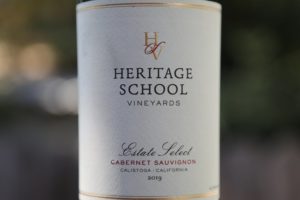
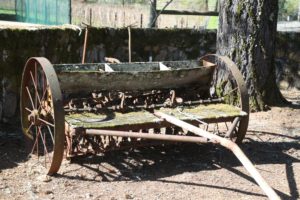
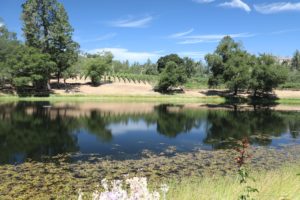 The 2019 Heritage School Vineyards Creekside Cabernet Sauvignon is deep ruby in color and nearly opaque; the first aromatic we noted was dark raspberry, accompanied by red plum and cherry along with notes of lavender, violets, dried rose petals and old cedar. We love the fact the bouquet is layered and offers both fruit and what we refer to as ‘character’, often expressed in more restrained Napa Valley bottlings of this variety. The acidity is the backbone of this wine with the palate showing more red fruited flavors than dark. These include red cherry, plum, and currant; the tannins are stony, lightly grainy and gravelly and persist beyond the fruit on the lively finish. We wouldn’t mind pairing this with an Italian beef based ravioli. This wine is drinking in a sweet spot 5 years post vintage at the time of our tasting. Of their bottlings, this wine is often favored to pair with a variety of cuisine due to its bright acidity.
The 2019 Heritage School Vineyards Creekside Cabernet Sauvignon is deep ruby in color and nearly opaque; the first aromatic we noted was dark raspberry, accompanied by red plum and cherry along with notes of lavender, violets, dried rose petals and old cedar. We love the fact the bouquet is layered and offers both fruit and what we refer to as ‘character’, often expressed in more restrained Napa Valley bottlings of this variety. The acidity is the backbone of this wine with the palate showing more red fruited flavors than dark. These include red cherry, plum, and currant; the tannins are stony, lightly grainy and gravelly and persist beyond the fruit on the lively finish. We wouldn’t mind pairing this with an Italian beef based ravioli. This wine is drinking in a sweet spot 5 years post vintage at the time of our tasting. Of their bottlings, this wine is often favored to pair with a variety of cuisine due to its bright acidity.
Lakeview
The 2019 Heritage School Lakeview Cabernet Sauvignon is deep ruby; the bouquet offers beautiful dark fruited aromatics with complementing attributes from its barrel aging. These scents including blackberry, boysenberry and dark cherry with dried herbs including sage along with a a darker savory character including old cedar box, petrichor and old leather. As the bouquet evolves it offers additional barrel influences including mocha and espresso. The bouquet is ripe but not over ripe. Finishes with loads of fruit including blackberry and dark cherry, accompanied by a darker spice character including of dried herb, sage and spicy plum skin. The texture is a hallmark character of this wine featuring chalky/gravelly and rounded tannins sporting a moderate long-lasting grip. If wines were organized into categories, this would clearly fall in the ‘crowd favorite’ section.
The 2014 Heritage School Casey’s Lakeview is deep ruby and opaque. This vineyard consistently delivers similar aromatics – the savory and moody bouquet reveals scents of sweaty leather, dried sage, dried cherry, and dark raspberry. However give this wine time; the bouquet evolves to its core of fruit, which displaces the more savory characteristics. On the palate there are flavors of plum, blackberry, boysenberry and dried herbs including sage. The chewy and firmly gripping tannins persist well beyond the fruit on the extended finish. The finish lingers savory with a dusty character, dried herbs and a note of white pepper. We tried this wine 10 years post vintage; it is remarkably youthful and still has loads of life ahead. Persists with lively mouth watering acidity.
Hillside
The 2021 Heritage School Hillside is deep ruby with purplish tinges on the rim; sweetly fruited, the bouquet also offers additional layers of baking species. The aromas are distinctive and include fig, dark raspberry, cherry, boysenberry, floral notes of dried rose petals, lilac and lavender along with a nuance of cinnamon. On the palate there are dark fruited flavors of plum, boysenberry, blackberry and Pakistani mulberry. Layered and complex, this wine reflects an exceptional vintage in Napa valley. The finish lingers with gravelly and grainy tannins and a long lasting dusty and chalky character. This is a pretty wine, yet also has plenty of depth and is going to be highly age worthy.
The 2019 Heritage School Hillside Vineyard Cabernet Sauvignon is deep ruby and opaque with an amaranthine rim; the bouquet is dark fruited with aromas of blackberry, boysenberry, Pakistani mulberry and dark cherry. This bouquet is deeply layered and its highly enjoyable to smell. It also offers notes of dark chocolate, espresso, mocha and a very light clove spice which is more in the background but is expressed more as the wine opens. Its focus is on its core fruit characteristics with the barrel influence a complementary character. This is a robust wines in terms of all three characteristic that we always look for in a Napa Valley hillside bottling: flavor, structure and acidity. In terms of texture, the broadly coating tannins are gravelly, dusty/earthy and persist in parallel with the fruit on the extended finish. Pair this with something from the BBQ, perhaps a Wagyu ribeye steak.
The 2014 Heritage School Vineyards Missiaen’s Hillside Vineyard Cabernet Sauvignon is noticeably dark crimson in the glass and is the darkest of their 2014 wines. This wine showcases darker fruit aromas along with a darker chocolate note on the bouquet and a slight savory quality including a hint of sage. Powerful but balanced on the palate this wine offers a more robust stature, representative of the higher skin to juice ratio this vineyard produces as compared to the other estate wines from this vintage. However, its texture still features an attractive seamless quality across the palate from the entry through the finish. The palate lingers with gravely long-lasting tannins complemented by loads of fruit.
Estate Select
A 3-barrel selection special wine is produced each year from the estate and is available only to wine club members. Winemaker Thomas Brown chooses what he feels are the best three barrels each vintage from the four vineyards. The first vintage of this was produced in 2012; at the time it was called the Estate Select Blend. The next vintage was produced in 2016. Today it is made every year and the name has been shortened to Estate Select.
The 2019 Heritage School Vineyards Estate Select is a blend of two barrels from Hillside Vineyard and one barrel from Lakeview Vineyard. This wine is deep ruby/purple and opaque in color. The bouquet is initially minerally, dusty and chalky with a graphite character. Earthy. But give this wine time to open and it will oblige by offering additional dark fruited aromatics of boysenberry preserves, blackberry, dark cherry and baked plum along with mocha, espresso and a subtle toasted oak character. Richly flavored this wine delivers pure pleasure, a dark fruited union of blackberry, blueberry, boysenberry, Persian mulberry and dark cherry with a lingering note of dark chocolate and cedar. Expecting a robust textural profile, we were surprised to discover the tannins are ripe, resolved and remarkably polished. And of all their wines in terms of texture, this bottling tends to the most approachable each year. The finish is long lasting with its fruit outpacing the texture – a rare attribute among Napa Valley hillside Cabernet Sauvignon bottlings where tannins are often the lasting impressions.
Harris Estate
The 2007 Harris Estate Cabernet Sauvignon from Jakes Vineyard, later called Julie’s Creekside Vineyard was named after the Harris’s original black lab, Jake. This vintage has a very distinctive nose – its earthy, with notes of mushrooms, sweaty leather and black cherry. As the wine breathes a wonderful core of sweet fruit starts to show. The wine is very dark in the glass. The entry is soft, rounded and immediately, despite the 15% alcohol, you can tell this wine offers decent acidity. The fruit is lively both on the bouquet and the pleasing palate shows notes of red licorice and tangy cherry.
The 2008 Harris Estate Indulgence is a blend of three Cabernet Sauvignon clones. It shows an appealing bouquet; the aromas are rich, offering red fruit scents accompanied by a slight dusty character. It’s an elegant nose but it simultaneously shows ripe California fruit with a hint of spiciness. The palate is bright, lively and features bright acidity. This wine has an especially long finish.
The Former School
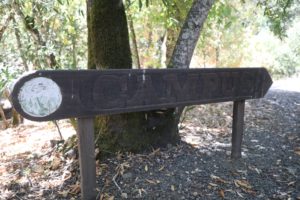
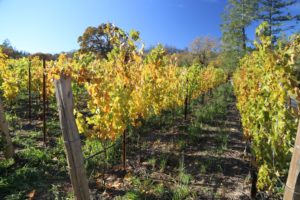 Heritage School is an appropriate name for the property; the Heritage School used to house a private boarding school for boys between the ages of 10-15. The school was founded in 1969 on the 170 acre Dixson Ranch owned at the time by Edward Dixson, who financed the operations in the early years. Dixson operated Dixson’s Distinctive Fashions in Menlo Park (a clothing store) in addition to owning this property.
Heritage School is an appropriate name for the property; the Heritage School used to house a private boarding school for boys between the ages of 10-15. The school was founded in 1969 on the 170 acre Dixson Ranch owned at the time by Edward Dixson, who financed the operations in the early years. Dixson operated Dixson’s Distinctive Fashions in Menlo Park (a clothing store) in addition to owning this property.
Former runner for the 1968 U.S. Olympic Track and Field team in Mexico City, Ron Whitney was the headmaster at this school for 24 years starting in 1969 when he was only in his late 20s. He began coaching at Santa Rosa Junior College in the late 1970s eventually taking over as head coach for track and field in 1993. In 1967 Whitney was ranked number one in the world for the 400 meter intermediate hurdles. He probably would have ran on the 1972 Olympic team but an injury just prior to the Olympics that year derailed his plans and he later trained for the 1976 Olympics, doing much of his work at Bailey Field (SRJC). He would often speak to various local organizations. He currently lives in neighboring Sonoma County.
Whitney and his business partner Eric Boutacoff purchased Heritage Ranch in 1972 from Dixson.
Heritage School grew from 8 students to around 50 students with a full time faculty staff of 13 (all holding Master’s degrees). And some of the teachers lived on site. Former bantam weight boxer Ray Loretta was the chef for a number of years. Students were housed in several bunkhouses/dormitories and or apartments and ranged in age from 8 to 16 years old. The property also featured a dining room (which doubled as a study hall in the evenings), a kitchen, lounge room, several classrooms, a small library and a gym which also was used for boxing. There was even a student store, barber and post office. An article in the The St. Helena Star dated December 10, 1970, describes all the buildings as in a style of the California Gold Rush days.
The school has been described as ‘unusual’, ‘different’ and rustic. Time at the school was extremely structured including strict wakeup and sleep times, meal times and study sessions, perhaps a reflection of Whitney’s own structured regiment he kept while training. The property was not only used as a school but also for retreats and hosting various performers. In 1971 a group of 93 Japanese students visited California as part of an overseas educational tour and stayed at Mountain Home Ranch (burned down the 2017 Tubbs Fire); these students visited The Heritage School where playing frisbee was one of the highlights. In 1973 the school was used to host 20 priests from Russian and Syrian orthodox churches. That same year Heritage School hosted accomplished violinist Shelly Hammett. Another event included hosting a local chapter of the Daughters of the American Revolution.
Participation in athletics was an important part of most students’ time at the Heritage School including running, baseball, basketball and football. Activities on site were numerous including use of the still existing 2-acre spring-fed pond for swimming, fishing, canoeing and raising pet ducks. In the early 1970s the school had what might have been the tallest badminton net on the planet; students cut down two trees on the property and fastened the net nearly 30 feet above the ground. In the mid 1980s the school was used to host open houses for the Napa Valley Tennis Camp.
Off campus visits and activities were also an integral part of the curriculum with various trips hosted primarily California but also other states in the Western U.S. and Canada. An article in The Napa Valley Register dated April 27, 1974 indicated the school’s trips in 1973 totaled 30,000 miles.
Winter Caravans were held every winter with trips to the Sierra Nevada mountains for snow activities including downhill and cross country skiing and snow camping. One trip in early 1974 was to Yosemite and involved time studying at the Yosemite Institute. Most trips involved outdoor experiences but some included visits to live theatre or local concerts. And with Whitney’s background in running, students of the Heritage School would run in the annual Blossom Hill Run held in Carneros in Napa Valley; in the mid 1970s, Whitney was the director of this race.An article in The St. Helena Star dated November 1, 1973 describes a special visit to Sterling Vineyards for 30 students of Heritage School. Sterling opened their tram for the first time in 1973; the students’ visit was soon after it had opened and was tied to learning about fermentation being taught in one of their science classes. The article describes the students as having an, “exciting ride up the funicular tram” with an inside look into the winery operations and visiting parts of the winery not open to the general public.
In 1972 through one of Whitney’s friends, Cecil the river otter was relocated to the property. Apparently Cecil enjoyed a career in Hollywood, with roles in several nature films. He grew up in an apartment and had access only to a swimming pool prior to the relocation. Other animals were donated and or raised on the property including chickens and horses.
The main building burned down in in the early morning of Friday September 10, 1992; its value was estimated to be about 1 million USD. The cause of the fire was thought to be a piece of clothing or bedding material that was left to close to an indoor heater. After a long run, the Heritage School declared bankruptcy in August 1994.
Several structures dating from when the school was operating are still standing including the old Victorian which previously served as the home for the headmaster and one of the administration buildings. The original bell used by the school hangs from the top of one of the buildings. These structures have since been remodeled. The main home, where we originally met Mike and Treva many years ago was designed by prominent architect, Howard Backen (died 2024).
We have a personal connection to this property. For several years, (decades ago) mountain climber and guide Valentin Trenev used to help Ron manage the property and oversee the school. Val potentially helped save my life in Nepal during a serious bout of altitude sickness combined with food poisoning – recognizing the dangerous symptoms of altitude sickness and carrying me on his shoulders at midnight from above 17,000 feet to a much lower elevation (with serious symptoms persisting all of the next day).
Val was also instrumental in setting up the rock-climbing areas on Mt. St. Helena in Robert Louis Stevenson State Park. And we see Val from time to time in Thailand, where he spends a good portion of the year these days and where we also have a house and spend our winter months.
—
Heritage School is a founding member of the Napa Valley based Mercury Wine Syndicate, an exclusive network of 27 primarily Napa Valley boutique wineries and producers. Membership is capped at 27 producers, with additional interested members added to a wait list. This syndicate is named in homage to Mercury the Roman god of communication and commerce. The name also refers to Napa County as in the latter half of the 1800s being a large producer of mercury, extracted from cinnabar ore from mines located primarily in Pope Valley and in the hills of the Vaca mountain range. The Mercury Wine Syndicate hosts member events and selected tastings both in Napa Valley and in other parts of the country.
Heritage School Vineyards produces only about 800 cases of Cabernet Sauvignon annually, although production has been as high as 1,200 cases. As a result, the majority of their wine is distributed through their mailing list. Occasionally the wines are available locally at ACME wine shop in Saint Helena and on the wine list at Brix Restaurant. Sometimes the Jenkins pour the wines at local premium tastings, including Calistoga Food & Wine, an event held every year at Solage Resort. And Heritage School Vineyards maintains a library of older vintages, especially useful during a year when they produced no wines such as 2020, due to fires in Napa Valley and the resulting problems with smoke taint.
The wines have been highly regarded by wine critic Jeb Dunnuck.
For more information, to purchase wine and or to join one of the membership levels in their Club 225 (appropriately named after the address of the property), visit: www.heritageschoolvineyards.com

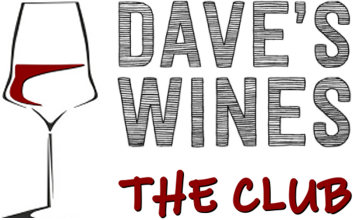




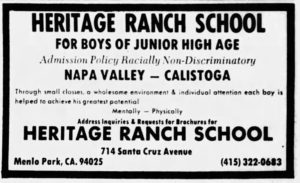
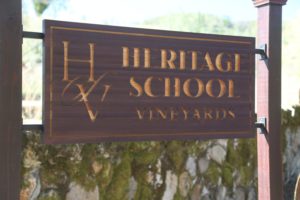
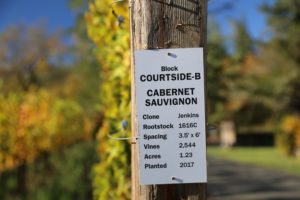
MIKE and Triva
Are you still making your wine? Miss seeing you.
Sandy Vaughan
Hi Sandy,
Treva and I are living the good life, drinking lots of “old” Harris Estate and doing some fly fishing and bird hunting. We would love to see you and Paige. I talked to Clair Amonette yesterday and heard how they lost everything. I hope you and the beautiful Country Club came out ok. I miss the trips to Moultrie quail hunting, that was a great experience with great guys. Let’s try and touch base.
Hi Mike & Treva ,
I have been missing and thinking of you guys so often .!
Mike you were my role model in dentistry and I never forget how we met with Treva and you offered me my first job in your beautiful busy office in Milpitas ! I am grateful to you and Treva and love you both.
I saw your beautiful land for sale and I was sad because I knew how much you loved it and even more you loved making wine !
I hope you are both healthy and well and have many grandchildren to keep you busy everyday .
Send me best to everyone and I love to see you guys if you are ever back in SF. Please keep in touch if you still have my number or email !
Big hug to Treva and we have so much to catch up !🥂💐 with gratitude always
Neda Oromchian